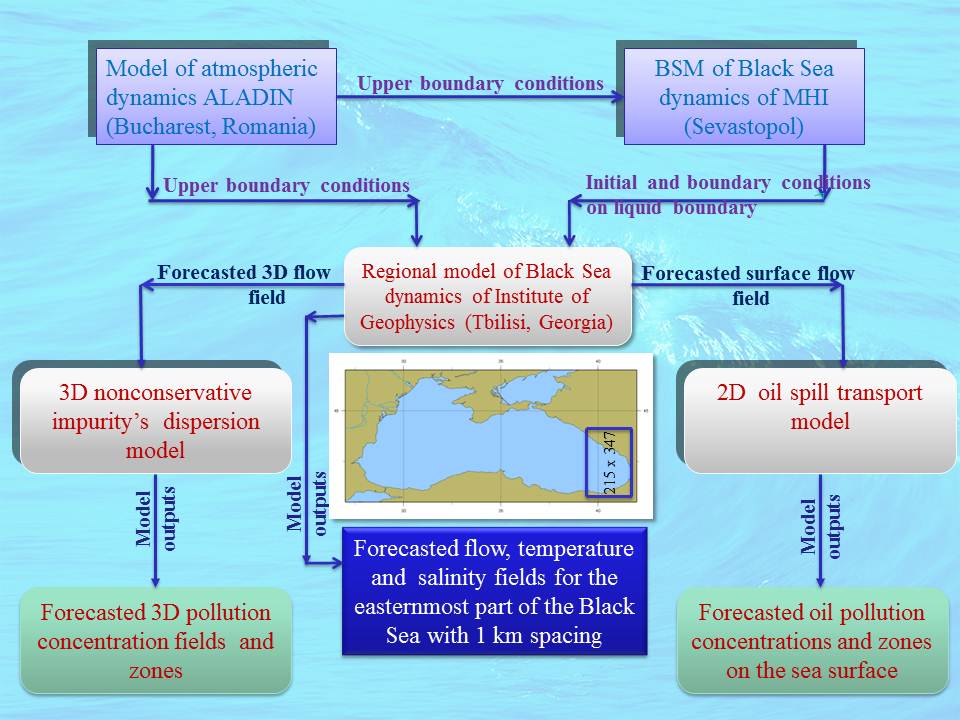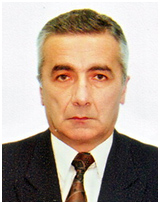Forecast of Hydrophysical Fields and propagation of polluting substances in the Georgian sector of the Black Sea on the basis of the regional forecasting system developed at M. Nodia Institute of Geophysics of Iv. Javakhisvili Tbilisi State University
A regional operational forecasting system for the Georgian sector of the Black Sea and surrounding water area (the regional area is separated from the open part of the sea by the liquid boundary coinciding with meridian 39.08E passing near city of Tuapse) is developed at the Department of Modeling the Sea and Atmospheric Dynamics of the M. Nodia Institute of Geophysics of Iv. Javakhishvili Tbilisi State University within the context of EU International scientific and technical projects ARENA and ECOOP. Further improvement of the forecasting system was carried out by support of Shota Rustaveli National Scientific foundation (2013-2015). The regional forecasting system is one of the parts of the Black Sea basin-scale Nowcasting/Forecasting System.
A new version of the regional system consists of hydrodynamic and ecological blocks. The hydrodynamic block includes a high-resolution 3D regional model of the Black Sea dynamics of the Institute of Geophysics (RM-IG) with 1 km spatial resolution, which is nested in the basin-scale model (BSM) of the Black Sea dynamics (with 5 km resolution) of Marine Hydrophysical Institute (MHI, Sevastopol). The ecological block consists of 2D and 3D models of spreading polluting substances in the sea environment.
The RM-IG is based on a complete system of ocean hydro and thermodynamics equations in hydrostatic approximation. The 2D and 3D models of spreading polluting substances are based on solution of advection-diffusion equations for non-conservative impurity using the sea current field predicted from the RM-IG. All required input data with one hour time step frequency corresponding to 3 days’ forecasting time period are available in a near operative mode from MHI via Internet. These data providing initial and boundary conditions for the RM-IG are:
- 3D initial fields of velocity components, temperature and salinity;
- on the open boundary – values of velocity components, temperature and salinity predicted by the BSM of MHI;
- on the sea surface – meteorological boundary fields predicted by the regional atmospheric model ALADIN or regional atmospheric model based on SCIRON forecasting system of Atmospheric Modelling and Weather Forecasting Group of University of Athens.
The regional forecasting system provides 3 days’ forecast of main hydrophysical fields – the current, temperature and salinity with 1 km spacing in the Georgian sector of the Black Sea and surrounding water area, but in accidental situations – also the forecast of spreading oil and other polluting substances.
The two-cycle splitting methods are used to solve problems included in the regional forecasting system. The forecasting area and structure of the regional forecasting system are shown in Figure.

On this web- site, 24, 48 and 72-hour forecasts of the current, temperature, and salinity can be found for z = 0, 20, 50 m horizons for the easternmost part of the Black Sea. Interested parties wishing to obtain more detailed prognostic information about these fields in visual or digital form may contact D. Demetrashvili.
Mob. +995 574 753 218, e-mail: demetr_48@yahoo.com
About authors
 Avtandil A. Kordzadze – Doctor of Sciences in Physics and Mathematics, Professor, Head of the Department of Mathematical Modeling Geophysical Processes in the Sea and Atmosphere at the M. Nodia Institute of Geophysics in 1989-2018.
Avtandil A. Kordzadze – Doctor of Sciences in Physics and Mathematics, Professor, Head of the Department of Mathematical Modeling Geophysical Processes in the Sea and Atmosphere at the M. Nodia Institute of Geophysics in 1989-2018.
In 1967 he graduated from Department of Mechanics and Mathematics of Novosibirsk State University (Russia). In 1967-1984 he worked at Computing Center of Siberian Branch of the Academy of Sciences USSR (Novosibirsk, Akademgorodok), in 1984-1989- – Senior Researcher at the Department of Computing Mathematics of the Presidium of Academy of Sciences USSR (Moscow; now – Institute of Numerical Mathematics of the Russian Academy of Sciences). In 1989 A. Kordzadze was transferred to the Institute of Geophysics (Tbilisi, Georgia), where he founded the Department of Sea Dynamics ( at present– Department of Modeling the Sea and Atmosphere Dynamics). For many years A. Kordzadze was teaching at the Novosibirsk State University, Moscow Institute of Physics and Technology, Javakhishvili Tbilisi State University. He was author of about 170 scientific publications on mathematical substantiation of problems of ocean dynamics, mathematical modelling of hydrothermodynamic and ecological processes in the Black Sea and Atmosphere.
Avtandil Kordzadze died on March 6, 2018.
 Demuri I. Demetrashvili – Doctor of Sciences in Physics and Mathematics, Head of the Department of Modelling the Sea and Atmosphere Dynamics at M. Nodia Institute of Geophysics of Iv. Javakhishvili Tbilisi State University.
Demuri I. Demetrashvili – Doctor of Sciences in Physics and Mathematics, Head of the Department of Modelling the Sea and Atmosphere Dynamics at M. Nodia Institute of Geophysics of Iv. Javakhishvili Tbilisi State University.
In 1971 he graduated from Department of Physics of Iv.
Javakhishvili Tbilisi State University (specialty “Theoretical Physics”). In 1974-1977 he was a post-gratitude student at the Computing Center of Siberian Branch of the Academy of Sciences USSR (Novosibirsk, Akademgorodok). In1992-1995 he worked as a deputy director of the Republican Center of Environmental Monitoring of the Ministry of Environmental Protection of Georgia. In 1982-1989 he was a Senior Scientist at the institute of Hydrometeorology and in 1996-2006 – Head of
Laboratory of Dynamical Meteorology at the same Institute. In 1989-2018 – Chief Scientist at Department of Mathematical Modeling of Geophysical processes in the Sea and Atmosphere of M. Nodia Institute of Geophysics.
D. Demetrashvili is author of more than 170 scientific publications on numerical modeling of hydrophysical fields and transport processes of different substances in the Black Sea and meso-scale atmospheric processes.
